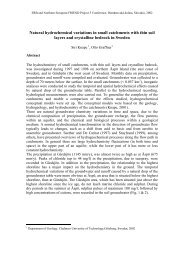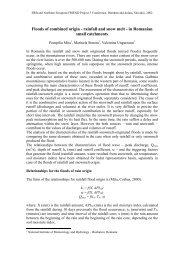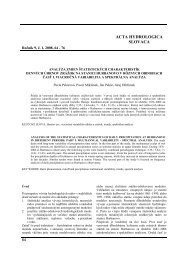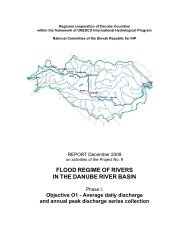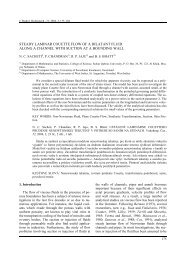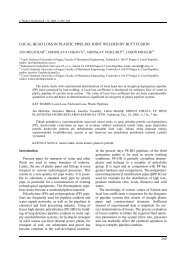analysis of seasonal extreme flows using peaks over threshold method
analysis of seasonal extreme flows using peaks over threshold method
analysis of seasonal extreme flows using peaks over threshold method
You also want an ePaper? Increase the reach of your titles
YUMPU automatically turns print PDFs into web optimized ePapers that Google loves.
P. Bača, V. Bačová Mitková<br />
As noted above, only the values <strong>of</strong> mean daily<br />
discharge were used for <strong>analysis</strong>. Linsley et al.<br />
(1949) reveal certain practical deficiencies <strong>of</strong> mean<br />
<strong>flows</strong>. The maximum mean daily <strong>flows</strong> never<br />
equals the peak flow, and only occasionally will the<br />
maximum 24-hr period coincide with a calendar<br />
day. The maximum daily flow rarely, therefore,<br />
represents the maximum 24-hr flow. Random timing<br />
<strong>of</strong> a hydrograph with respect with calendar days<br />
frequently results in a maximum mean daily flow<br />
on a day other than on which the actual instantaneous<br />
peak flow occurred. Secondary flood <strong>peaks</strong><br />
may be masked by the averaging <strong>of</strong> flow to compute<br />
mean daily values.<br />
In order to compute missing instantaneous peak<br />
values, relationship for predicting the missing data<br />
from the recorded mean daily flow for the day on<br />
which the instantaneous value occurred can be used<br />
(McCuen and Beighley, 2003). However, satisfying<br />
records <strong>of</strong> instantaneous peak values were not<br />
available.<br />
In spite <strong>of</strong> the uncertainties regarding to mean<br />
daily data, it may be concluded that occurrence<br />
frequency <strong>of</strong> <strong>extreme</strong> events decreased <strong>over</strong> the 40<br />
years period in the study Rybárik basin. Human<br />
alterations such as conversion <strong>of</strong> forest to agricultural<br />
land uses or others, which can be related to<br />
changes in event frequency (Huntington, 2006),<br />
have not been carried out <strong>over</strong> the 40 years period.<br />
Thus, it is most likely that influence <strong>of</strong> climatic<br />
changes on increase in run<strong>of</strong>f, which are suggested<br />
to take place in northern hemisphere, based on the<br />
results <strong>of</strong> modelling studies (Manabe et al., 2004),<br />
has not been recorded yet in the Rybárik basin. The<br />
results <strong>of</strong> this study are consistent with the conclusions<br />
<strong>of</strong> the <strong>analysis</strong> in mountains catchments in<br />
Central Slovakia <strong>over</strong> the 1962 – 2001 period published<br />
by Holko and Kostka (2005). Similarly, in<br />
Canada, increasing temperature combined with<br />
almost no change in precipitation, resulted in no<br />
change in annual streamflow from 1947 to 1996 for<br />
most regions (Zhang et al., 2001). The basins studied<br />
in North America were selected because <strong>of</strong><br />
minimal human perturbations to the water cycle.<br />
Conclusion<br />
This review reports changes in occurrence frequency<br />
<strong>of</strong> <strong>extreme</strong> mean daily discharge values<br />
<strong>over</strong> the 1964/65 – 2003/04 period in the small<br />
agricultural Rybárik basin placed in the flysh region.<br />
Peaks <strong>over</strong> <strong>threshold</strong> <strong>method</strong> was used for<br />
detection <strong>of</strong> changes in discharge values <strong>over</strong><br />
<strong>threshold</strong>s selected separately for hydrological<br />
events caused by snow melting in winter seasons<br />
and rainfall in summer seasons in single decades.<br />
The frequency <strong>of</strong> POT events has decreased in<br />
the past two decades (1984/85 – 1993/94 and<br />
1994/95 – 2003/04). The results reveal that the<br />
most <strong>extreme</strong> values <strong>of</strong> mean daily discharge occurred<br />
in the 1964/65 – 1973/74 (mostly in summer)<br />
and 1974/75 – 1983/84 (especially in winter)<br />
periods. The former decade emerges as the decade<br />
with the most <strong>extreme</strong> mean daily discharge values<br />
recorded <strong>over</strong> the period studied. However, higher<br />
values generally occurred during snow melting.<br />
Human alterations, which can result in increase<br />
or decrease in flood frequency, have not been carried<br />
out <strong>over</strong> the 40 years period. The results presented<br />
imply that influence <strong>of</strong> climatic changes on<br />
intensification <strong>of</strong> hydrological cycle has not been<br />
recorded yet in the Rybárik basin. The role <strong>of</strong> climatic<br />
changes and its influence on flood frequency<br />
still remains questionable. The next research should<br />
also include catchments where flash floods caused<br />
by intensive rainfall events occurred in the last<br />
years. As suggested, not only climatic changes but<br />
also human alterations such as conversion <strong>of</strong> forest<br />
to agricultural land uses should be taken into account<br />
in flood frequency <strong>analysis</strong>.<br />
Acknowledgements. This research was supported by<br />
the Science and Technology Assistance Agency<br />
(Slovakia) under contract no. APVT-7804 and by<br />
the Science Granting Agency (Slovakia) under contract<br />
no. VEGA-5055.<br />
REFERENCES<br />
AIZEN V.B., AIZEN E.M., MELACK J.M., DOZIER J., 1997:<br />
Climatic and hydrologic changes in the Tien Shan, Central<br />
Asia. J. Clim., 10, 1393–1404.<br />
BAYLISS A.C., 1999: Catchment descriptors. Flood estimation<br />
handbook, vol. 5., Institute <strong>of</strong> Hydrology, Wallingford.<br />
BLACK A.R., BURNS J.C., 2002: Re-assessing the flood risk<br />
in Scotland. The Sci. <strong>of</strong> the Total Environ., 294, 169–184.<br />
CHOW V.T., MAIDMENT D.R., MAYS L.W., 1988: Applied<br />
hydrology. McGraw-Hill, New York, NY.<br />
FOSTER M.J., WERRITTY A., SMITH K., 1997: The nature,<br />
causes and impacts <strong>of</strong> recent hydroclimatic variability in<br />
Scotland and Northern Ireland. Proceedings, Sixth National<br />
Hydrology Symposium. Wallingford: British Hydrological<br />
Society.<br />
GREŠKOVÁ A., 2005: Analysis <strong>of</strong> selected basin parameters<br />
from the point <strong>of</strong> wiev <strong>of</strong> flash flood occurrence. Geographical<br />
J., 57, 2, 131–144.<br />
HOLKO L., KOSTKA Z., 2005: Analýza maximálneho denného<br />
prietoku v horských povodiach stredného Slovenska.<br />
20




